Optimisation Configuration of Overhead-Line Segmentation Switch of a Distribution Network Based on Global Combination Criterion
Abstract
:1. Introduction
- (1)
- By comprehensively considering reliability and economy, an optimisation algorithm for the distribution switch of an overhead line segment in a distribution network based on the global combination criterion is proposed, and the switch-configuration scheme is further optimised to effectively improve the utilisation rate of the equipment, reduce the scope of faults, and improve the power supply reliability.
- (2)
- Simultaneously, we determine multiple switch positions using a global combination criterion. Compared with [28,29] that employed a single-switch criterion to determine one switch at a time, the method of repeated iterative optimisation to determine the switch position is more direct. Further, it does not fall into a local optimum. The calculation speed is also very fast while ensuring global optimum.
- (3)
- This paper proposes to further optimise the number of switches based on the optimal switch position and reflects the optimisation effect of the method on the number of switches. The use of the optimised optimal switch-position data to determine the number of switches is obviously better than that in [28,29]. The number of switches determined by the switch-position data before optimisation is more accurate and reasonable.
2. Relevant Definition and Reliability-Index Selection
2.1. Related Definitions
- (1)
- Node: connection point of the feeder and distribution transformer. The connection point of the primary branch and trunk is defined as a node.
- (2)
- Line segment: a line that connects two nodes without a load is defined as a line segment.
- (3)
- Line power supply end: the end of a line section close to the main power supply (standby power supply) is defined as the main power supply end (backup power supply end) of a line section.
2.2. Power Supply Reliability Index
2.3. Power Supply Reliability Evaluation Method
3. Constructing the Objective Function
3.1. Objective Function
- y—number of section switches
- R(y)—reliability comprehensive index value
- SAIDI(y)—SAIDI of y switches normalised before multiplying the weights
- ENS(y)—ENS for y switches, which is normalised before multiplying the weights
3.2. Restrictions
- (1)
- Power system inequality constraints
- (2)
- Power system equality constraints
- (3)
- Maximum effective-segment-condition constraints
- (4)
- Economic constraints
- (5)
- Reliability constraints
4. Optimal Switch Configuration Based on Global Combination Criterion
4.1. Definition of Related Quantity
4.2. Switch Global Combination Criterion
- (1)
- Criterion for global switch combination without a tie line
- t1—time required for fault repair
- t2—Power-outage time in line B when line A fails. (The value of t2 when a circuit breaker is used as a switch is zero, and that of t2 when a load switch is used is the sum of the time required for the fault location and isolation and the time required for the switch to trip). Line A indicates the part that needs to be isolated and repaired after the fault. Line B indicates the part that can normally supply power after the fault is isolated.
- λ—Line failure rate
- (2)
- Criterion for global combination of switches with tie lines
- (3)
- Advantages of the global switch-combination criterion compared with the single-switch criterion
- All candidate position criteria are first calculated. A switch is then installed at the best point.
- After the installation of the first switch, the criteria for the remaining positions need to be recalculated. The maximum value is then determined, and the second switch is installed.
- Step b is repeated until four switches are installed.
- Due to the installation of the additional switches, the criterion for the position of the previously installed switch also changes and is not optimal. Thus, recalculating the position is necessary to individually find the optimal positions until no change in the switch position occurs. In addition, global optimality is not guaranteed.
4.3. Alternate Switch Position
- (1)
- No contact line section
- (2)
- Link section is present
4.4. Determination of the Installation Position and Number of Switches
- According to whether the line is connected or not, all alternative installation positions are regarded as undetermined positions. The number of switches is denoted as n, and initial switch number y is considered as one.
- We find the most suitable y positions among the n switch positions to install y switches. According to the connection of the line (zero) and the global combination criterion in Equation (15) [Equation (11)], the values of the C(n, y) combination schemes are calculated in sequence. The corresponding switch position is identified when the maximum value is found, which is the optimal switch position when y switches are installed.
- We determine whether the constraint condition is satisfied, i.e., if y = y + 1, step b is repeated; otherwise, step d is performed.
- We output the optimal position and number of y − 1 switches.
4.5. Algorithm Flow
5. Calculation Example and Optimisation-Effect Analysis
5.1. Example 1
| Example | Contact Line | Graphics | Configure |
|---|---|---|---|
| Example 1 (Actual feeder data in Reference 28) | no contact | Figure 6 | Alternative switch-position map |
| Figure 8 | Optimal switch-distribution map (two switches) | ||
| Figure 9 | Optimal switch-distribution map (three switches) | ||
| with contact | Figure 7 | Alternative switch-position map | |
| Figure 10 | Optimal switch-distribution map (four switches) | ||
| Figure 11 | Optimal switch-distribution map (five switches) | ||
| Example 2 (Actual feeder data in a certain place) | with contact | Figure 12 | Alternative switch-position map |
| Figure 13 | Optimal switch-distribution map |
5.2. Example 2
6. Conclusions
- (1)
- Considering the reliability and economy comprehensively, multiple switch positions are judged at the same time through the global combination criterion. Compared with the method of repeatedly iteratively optimizing and determining the switch position using the single switch criterion in literatures [28,29], it is not only more direct, and does not get stuck in a local optimum. When there is no tie switch in the first example, the method in this paper reduces the ENS by 2.47% compared with the literature [29], which effectively improves the utilization rate of the equipment.
- (2)
- This paper proposes to further optimize the number of switches based on the optimal switch position. In example 1, the ENS of this paper is reduced by 20.38% and 24.80% compared with the literature [28] and literature [29], respectively. In example 2, the comprehensive index of the method in this paper is reduced by 26.05%, SAIDI by 26.82%, and comprehensive reliability index by 26.42% compared with the ENS before optimization. It can be seen that it is obviously more reasonable to use the optimized optimal switch position data to determine the number of switches, which not only ensures the global optimum of the switch position, but also ensures the optimum number of switches, so that the reliability index value is greatly reduced and the reliability is significantly improved.
Author Contributions
Funding
Data Availability Statement
Conflicts of Interest
References
- Zhang, W. Research on Index System and Evaluation Methods of Distribution Network Fault Outage Risk Assessment; North China Electric Power University: Beijing, China, 2014. (In Chinese) [Google Scholar]
- Heidari, A.; Agelidis, V.G.; Kia, M. Considerations of sectionalizing switches in distribution networks with distributed generation. IEEE Trans. Power Deliv. 2015, 30, 1401–1409. [Google Scholar] [CrossRef]
- Zhao, H.; Wang, Z.; Xie, K.; Li, W. Comparative study on reliability assessment methods for medium voltage distribution network. Electr. Power Autom. Equip. 2013, 37, 3295–3302. (In Chinese) [Google Scholar]
- Peng, H.; Zhang, J.; Wu, Y.; Sun, M.; Wang, Z. Segment optimization based on reliability index for mid voltage overhead eeder. Electr. Power Autom. Equip. 2017, 37, 184–190. (In Chinese) [Google Scholar]
- Alam, A.; Pant, V.; Das, B. Optimal placement of protective devices and switches in a radial distribution system with distributed generation. IET Gener. Transm. Distrib. 2020, 14, 4847–4858. [Google Scholar] [CrossRef]
- Wan, G.; Guo, X.; Ren, Z. Study on layout of disconnect switches of distributed system. Relay 2002, 30, 10–12. (In Chinese) [Google Scholar]
- Wan, G.; Ren, Z.; Jing, Y. Deployment of disconnected switches on main feeder. Proc. CSEE 2003, 23, 124–127+176. (In Chinese) [Google Scholar]
- Cao, H.; Chen, Y.; Wu, Y.; Gao, C.; Zhang, J.; Liu, Y. General quantitative expression of optimal segment number of MV feeder. Power Syst. Technol. 2019, 43, 2991–2997. (In Chinese) [Google Scholar]
- Sun, L.; Yang, H.; Ding, M. Mixed integer linear programming model of optimal placement for switching devices in distribution system. Autom. Electr. Power Syst. 2018, 42, 87–95. (In Chinese) [Google Scholar]
- Moradijoz, M.; Moradijoz, S.; Moghaddam, M.P.; Haghifam, M.R. Flexibility enhancement in active distribution networks through a risk-based optimal placement of sectionalizing switches. Reliab. Eng. Syst. Saf. 2020, 201, 106985. [Google Scholar] [CrossRef]
- Wang, C.; Pang, K.; Shahidehpour, M.; Wen, F.; Ren, H.; Liu, Z. Flexible Joint Planning of Sectionalizing Switches and Tie Lines Among Distribution Feeders. IEEE Trans. Power Syst. 2021, 37, 1577–1590. [Google Scholar] [CrossRef]
- Ma, S.; Su, L.; Wang, Z.; Qiu, F.; Guo, G. Resilience Enhancement of Distribution Grids Against Extreme Weather Events. IEEE Trans. Power Syst. 2018, 33, 4842–4853. [Google Scholar] [CrossRef]
- Zhang, M.; Qin, P.; Chen, Y.; He, S.; Wang, Z. Research on optimal configuration method of sectionalized and tie switches in low voltage distribution network. Power Capacit. React. Power Compens. 2020, 41, 138–144. [Google Scholar]
- Zhang, Y.; Hu, J. Application of self regulating genetic algorithm in optimal switch configuration of distribution network. Shanxi Electr. Power 2011, 5–8. [Google Scholar]
- Liu, L.; Jiang, X.; Cai, J.; Zheng, W. LCC oriented segmented optimization of medium voltage distribution network based on discrete particle swarm optimization. East China Power 2014, 42, 1684–1690. [Google Scholar]
- Xu, Y.; Liu, C.C.; Schneider, K.P.; Ton, D.T. Placement of remote-controlled switches to enhance distribution system restoration capability. IEEE Trans. Power Syst. 2015, 31, 1139–1150. [Google Scholar] [CrossRef]
- Liu, D. Reliability Analysis of Distribution Network and Research on Optimal Configuration of Section Switch and Fault Indicator; Beijing Jiaotong University: Beijing, China, 2015. [Google Scholar]
- Zhang, B.; Crossley, P. Reliability improvement using ant colony optimization applied to placement of sectionalizing switches. Energy Procedia 2017, 142, 2604–2610. [Google Scholar] [CrossRef]
- Yin, Y.; Zhang, G.; Ge, J.; Chu, K. Research on the optimization method of reliability index based on the configuration of the main feeder section switch of high-voltage distribution network. Tech. Autom. Appl. 2018, 37, 98–102+110. [Google Scholar]
- Yu, T.; Li, X. Optimal configuration of switches in distribution network based on LCC and improved BDE method. Electr. Meas. Instrum. 2015, 52, 96–100. [Google Scholar]
- Zhang, J.; Lin, H.; Cai, J. Research on Optimal Configuration of Rural Distribution Network Switches. Electrotech. Electric. 2015, 5–9, 15. [Google Scholar]
- Benavides, A.J.; Ritt, M.; Buriol, L.S.; França, P.M. An iterated sample construction with path relinking method: Application to switch allocation in electrical distribution networks. Comput. Oper. Res. 2013, 40, 24–32. [Google Scholar] [CrossRef]
- Wang, Z.; Luo, F.; Zhu, L.; Wei, Z. Mode segmentation and connection optimization configuration method for medium voltage distribution network. J. Electr. Power Syst. Autom. 2015, 27, 83–89. [Google Scholar]
- Zhang, T.; Wang, C.; Luo, F.; Li, P.; Yao, L. Optimal design of the sectional switch and tie line for the distribution network based on the fault incidence matrix. IEEE Trans. Power Syst. 2019, 34, 4869–4879. [Google Scholar] [CrossRef]
- Abiri-Jahromi, A.; Fotuhi-Firuzabad, M.; Parvania, M.; Mosleh, M. Optimized sectionalizing switch placement strategy in distribution systems. IEEE Trans. Power Deliv. 2011, 27, 362–370. [Google Scholar] [CrossRef]
- Jooshaki, M.; Karimi-Arpanahi, S.; Lehtonen, M.; Millar, R.J.; Fotuhi-Firuzabad, M. Electricity distribution system switch optimization under incentive reliability scheme. IEEE Access 2020, 8, 93455–93463. [Google Scholar] [CrossRef]
- Jooshaki, M.; Karimi-Arpanahi, S.; Lehtonen, M.; Millar, R.J.; Fotuhi-Firuzabad, M. Reliability-oriented electricity distribution system switch and tie line optimization. IEEE Access 2020, 8, 130967–130978. [Google Scholar] [CrossRef]
- Zhang, J. Research on Models and Algorithms of Sectionalizing Switch Placement of a Medium Voltage Overhead Line; Chongqing University: Chongqing, China, 2014. (In Chinese) [Google Scholar]
- Liao, Y.; Zhang, J.; Wang, Z.; Zhang, Y. Three-stage optimization algorithm for the sectionalizing switch placement of a medium voltage overhead line. Power Syst. Technol. 2018, 42, 3413–3419. (In Chinese) [Google Scholar]
- Liao, Y. Research on Three-Stage Optimization Methods of Switch Placement on a Medium Voltage Overhead Line; Chongqing University: Chongqing, China, 2018. (In Chinese) [Google Scholar]
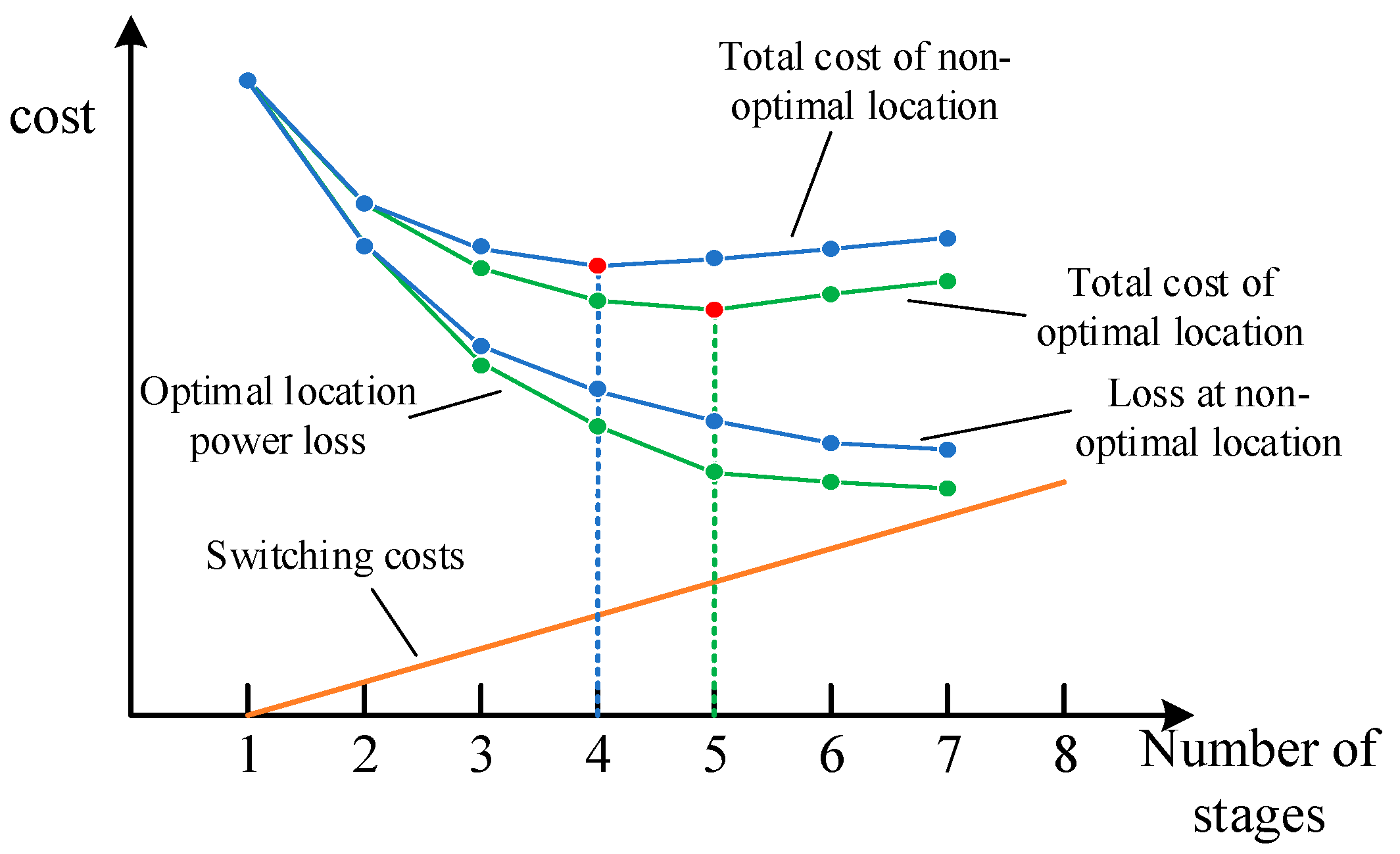

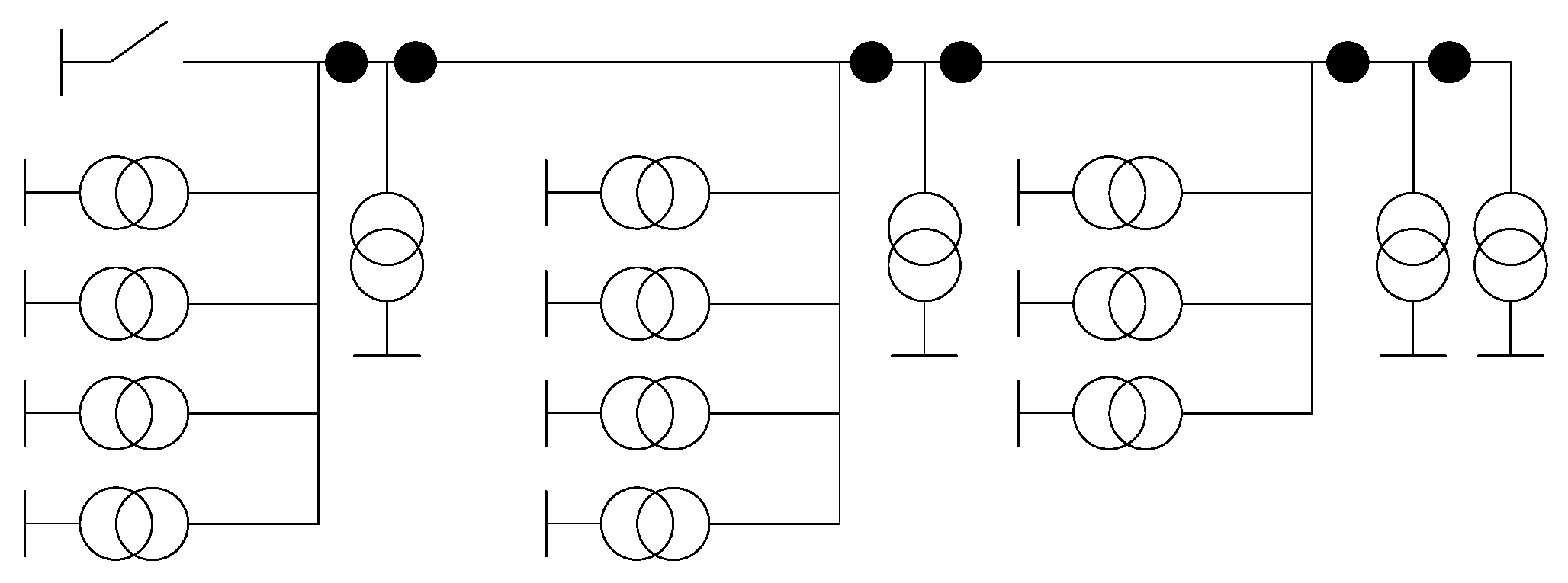

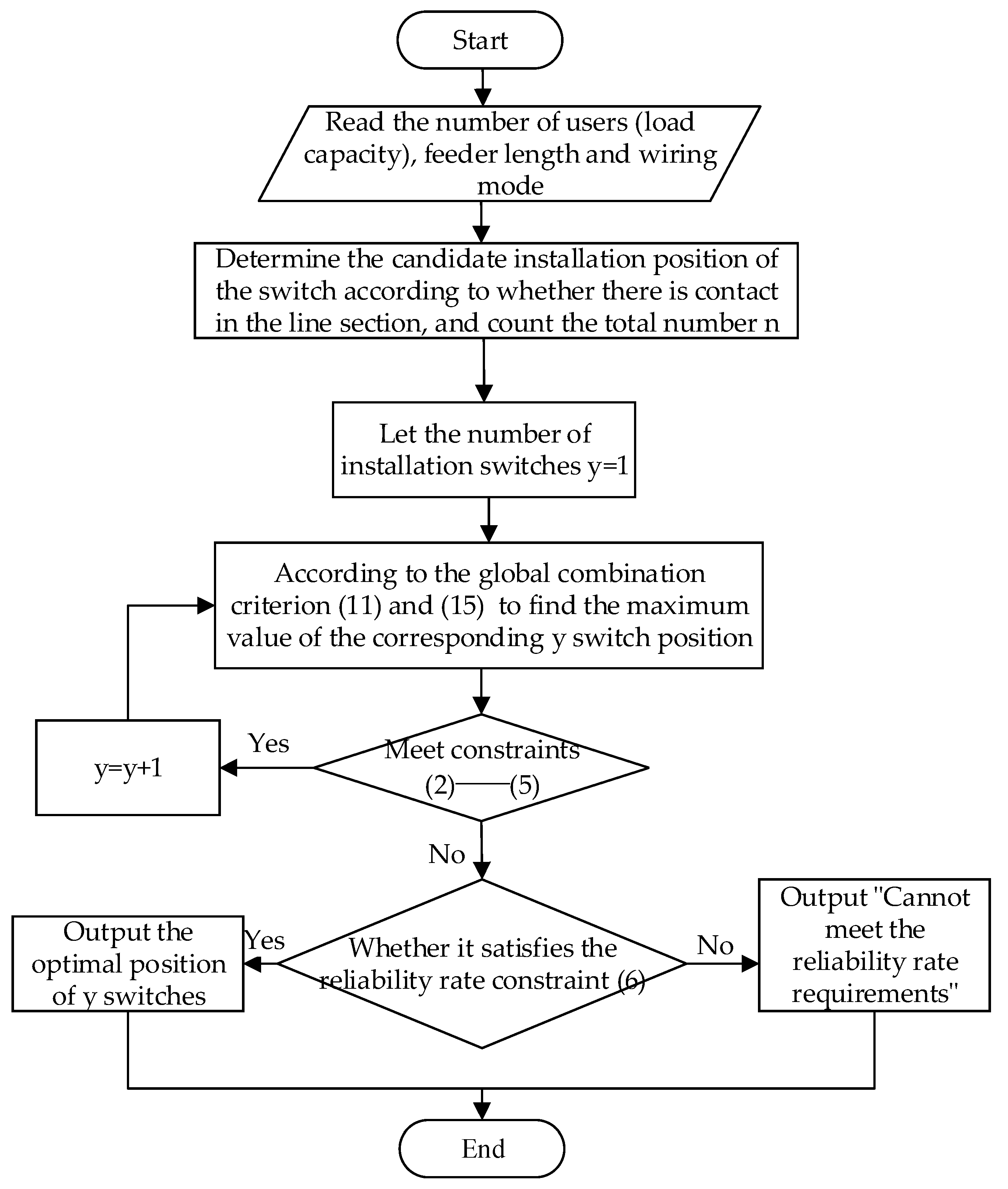



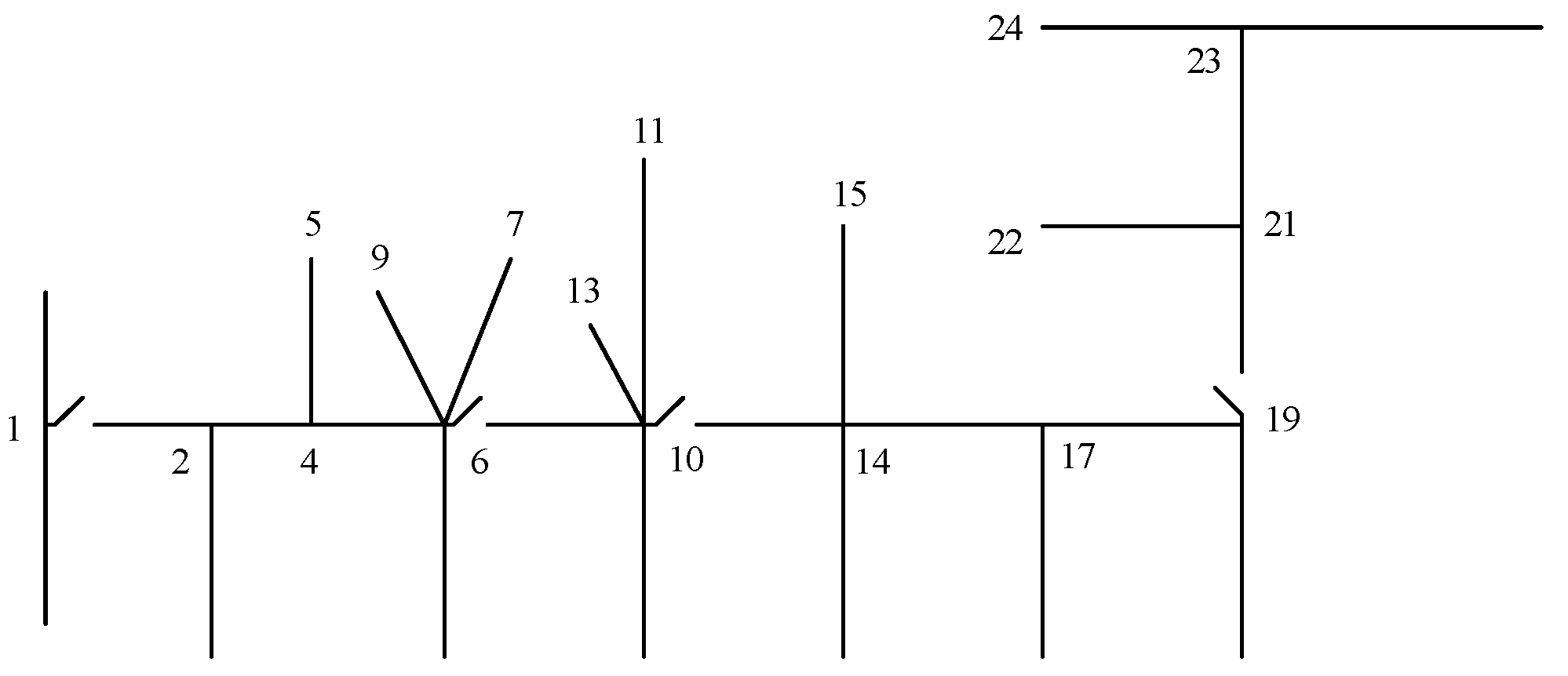
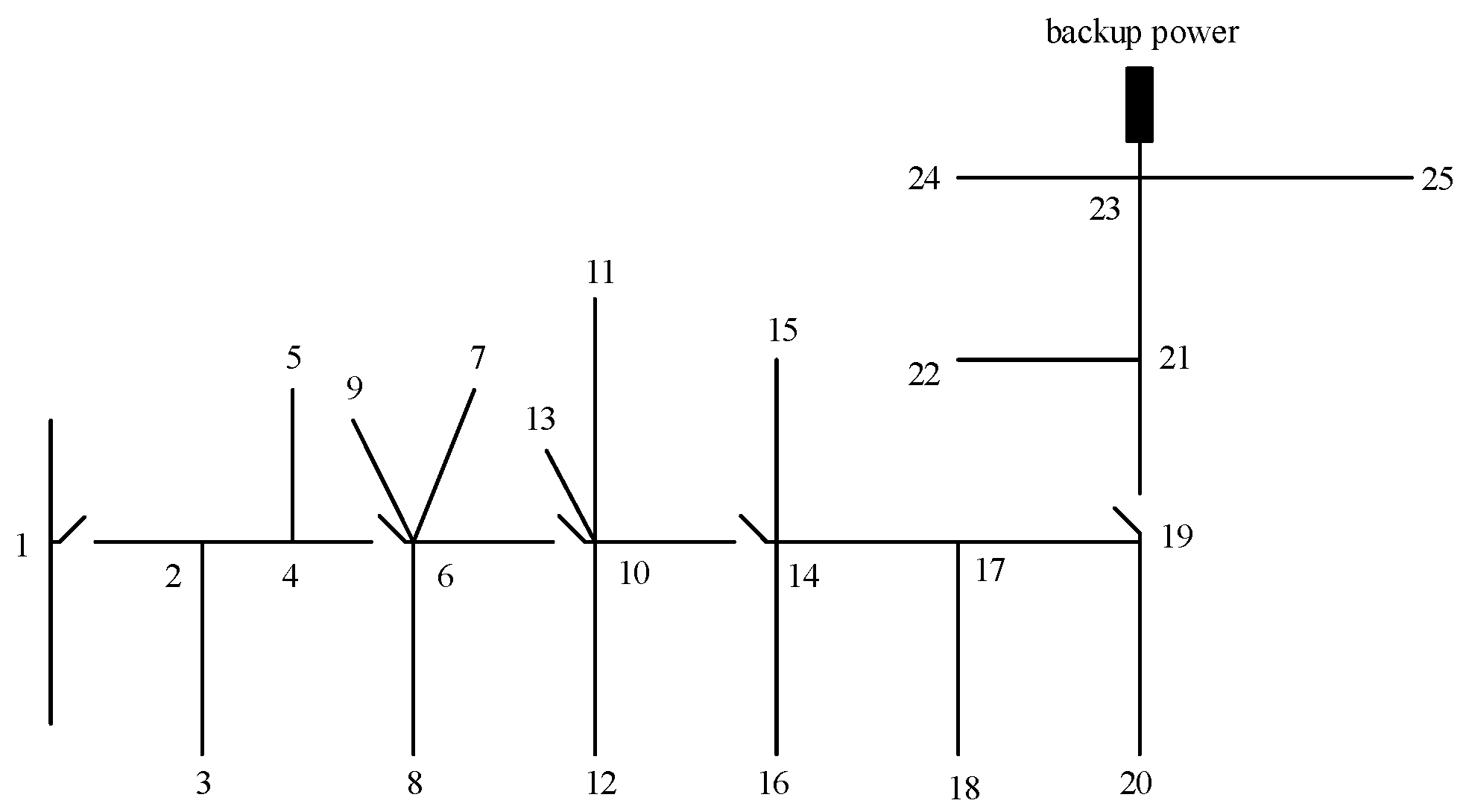

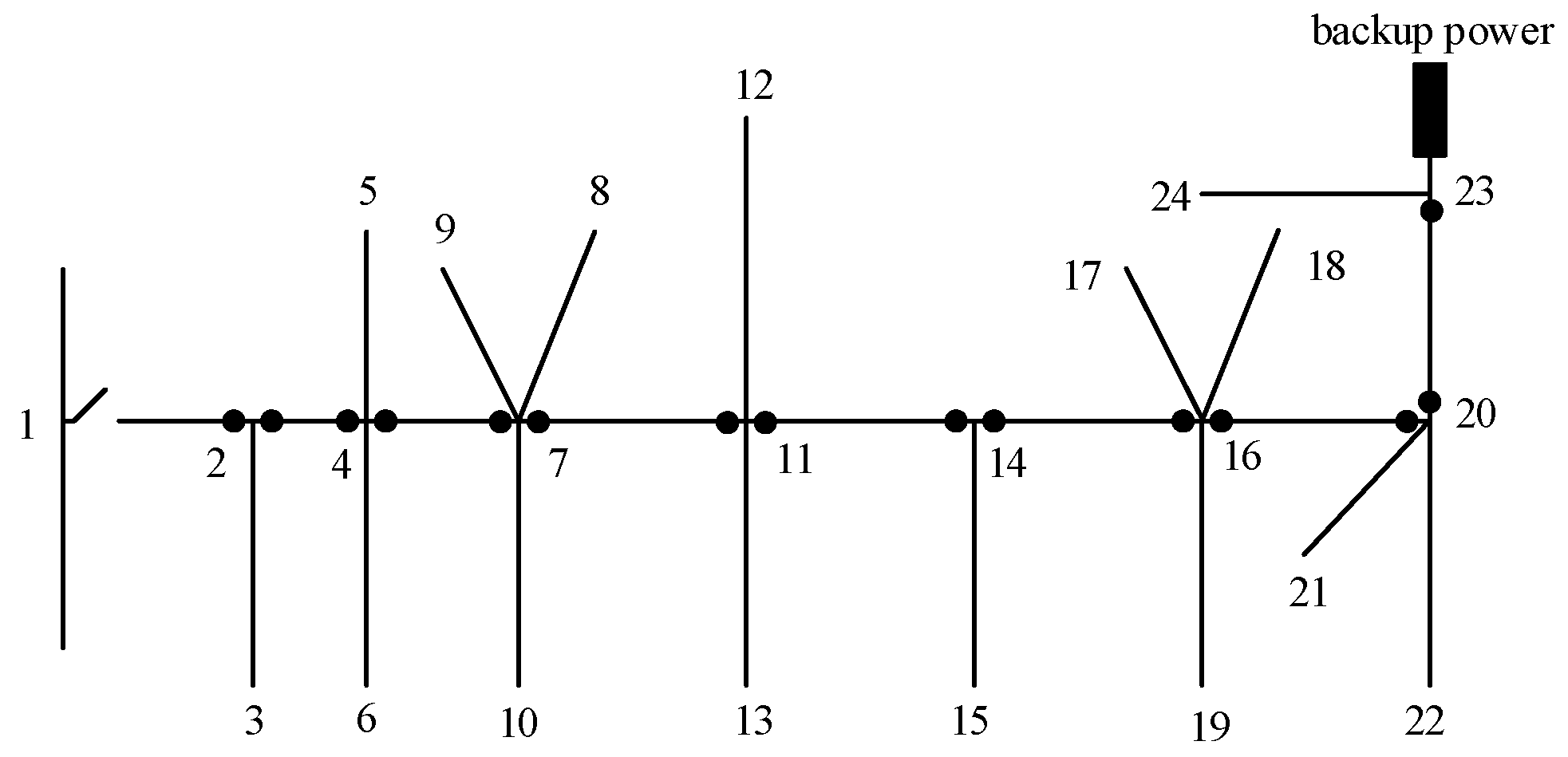
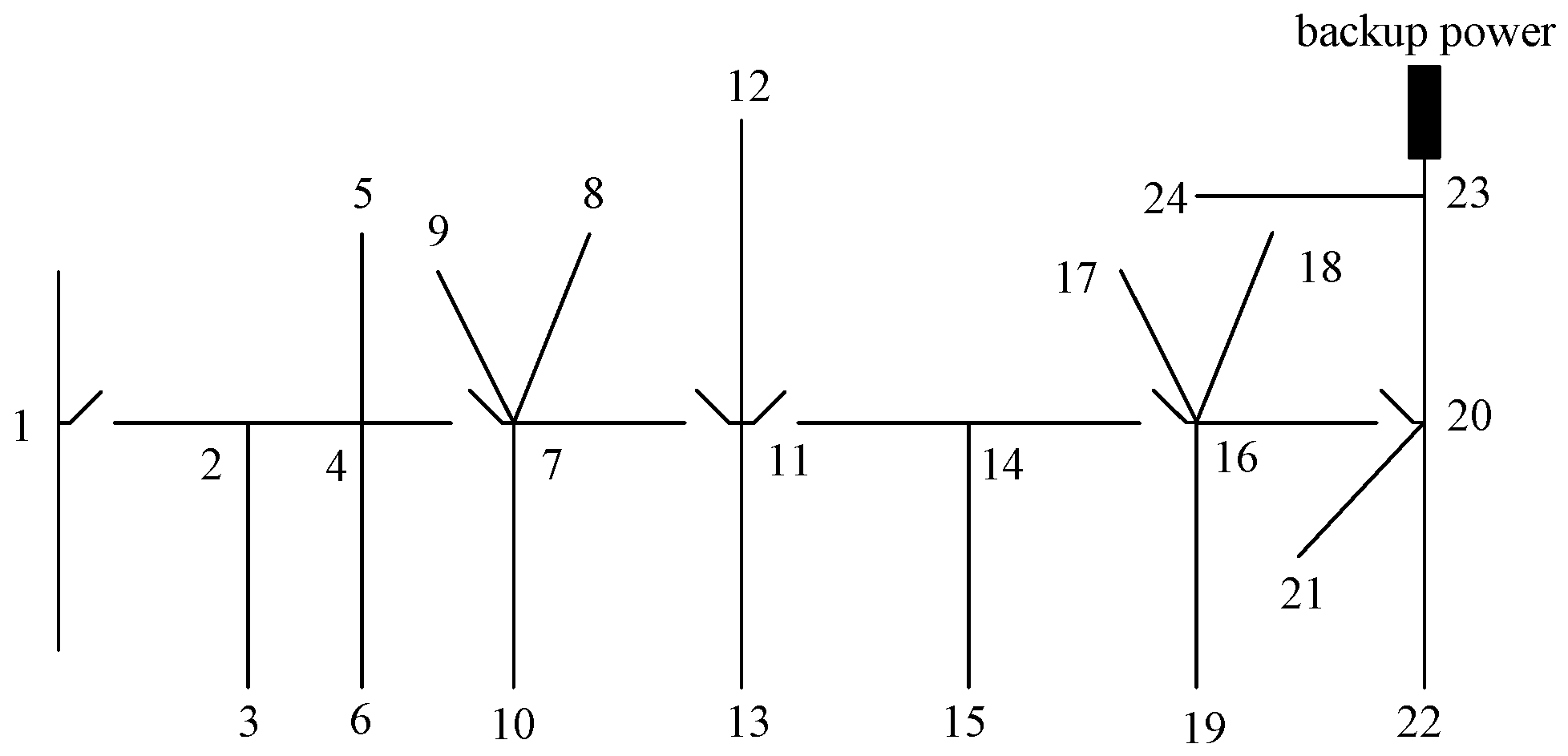
| Starting Point | End | Line Length (km) | Load (kW) |
|---|---|---|---|
| 1 | 2 | 0.403 | |
| 2 | 3 | 0.120 | 192 |
| 2 | 4 | 0.524 | |
| 4 | 5 | 0.480 | 201 |
| 4 | 6 | 0.610 | |
| 6 | 7 | 0.000 | 134 |
| 6 | 8 | 0.220 | 201 |
| 6 | 9 | 0.000 | 128 |
| 6 | 10 | 0.263 | |
| 10 | 11 | 0.000 | 201 |
| 10 | 12 | 0.936 | 639 |
| 10 | 13 | 0.815 | 361 |
| 10 | 14 | 0.583 | |
| 14 | 15 | 0.000 | 658 |
| 14 | 16 | 0.400 | 201 |
| 14 | 17 | 0.195 | |
| 17 | 18 | 0.000 | 383 |
| 17 | 19 | 0.200 | |
| 19 | 20 | 0.200 | 639 |
| 19 | 21 | 0.204 | |
| 21 | 22 | 0.140 | 255 |
| 21 | 23 | 0.604 | |
| 23 | 24 | 0.000 | 255 |
| 23 | 25 | 0.400 | 243 |
| Wiring Mode | Method | Switch Position | ENS (MW·h/Year) |
|---|---|---|---|
| No contact | Present study | 10–14 Power terminal 19–21 Power terminal | 3.851 |
| Reference [14] | 6–10 Power terminal 14–17 Power terminal | 3.900 | |
| Present study | 6–10 Power terminal 10–14 Power terminal 19–21 Power terminal | 3.593 | |
| Reference [15] | 4–6 Power terminal 10–14 Power terminal 19–21 Power terminal | 3.684 | |
| With contact | Present study | 4–6 Standby power terminal 6–10 Standby power terminal 10–14 Standby power terminal 19–21 Main power terminal | 1.013 |
| Reference [14] | 4–6 Standby power terminal 6–10 Standby power terminal 10–14 Main power terminal 17–19 Standby power terminal | 1.055 | |
| Reference [15] | 4–6 Standby power terminal 10–14 main power terminal 10–14 Standby power terminal 19–21 Main power terminal | 1.117 |
| Starting Point | End | Line Length (km) | Load (kW) | Number of Users (Household) |
|---|---|---|---|---|
| 1 | 2 | 0.604 | ||
| 2 | 3 | 0.204 | 204 | 53 |
| 2 | 4 | 0.420 | ||
| 4 | 5 | 0.000 | 142 | 41 |
| 4 | 6 | 0.231 | 246 | 72 |
| 4 | 7 | 0.368 | ||
| 7 | 8 | 0.000 | 436 | 137 |
| 7 | 9 | 0.273 | 234 | 83 |
| 7 | 10 | 0.852 | 174 | 66 |
| 7 | 11 | 0.497 | ||
| 11 | 12 | 0.000 | 387 | 132 |
| 11 | 13 | 0.465 | 589 | 203 |
| 11 | 14 | 0.373 | ||
| 14 | 15 | 0.742 | 628 | 258 |
| 14 | 16 | 0.405 | ||
| 16 | 17 | 0.295 | 291 | 139 |
| 16 | 18 | 0.000 | 336 | 115 |
| 16 | 19 | 0.300 | 283 | 93 |
| 16 | 20 | 0.520 | ||
| 20 | 21 | 0.000 | 335 | 102 |
| 20 | 22 | 0.380 | 278 | 92 |
| 20 | 23 | 0.434 | ||
| 23 | 24 | 0.000 | 377 | 127 |
| Considered Indicators | Switch Position | SAIDI (h/ (Household Year)) | ENS (MW·h/ Year) | Value of the Objective Function under the Composite Indicator (Normalised) |
|---|---|---|---|---|
| Optimal under comprehensive index | 4–7 Standby power terminal 7–11 Standby power terminal 11–14 Main power terminal 14–16 Standby power terminal 16–20 Standby power terminal | 0.1719 | 0.8519 | 0.155902 |
| Optimal under ENS index | 4–7 Standby power terminal 7–11 Standby power terminal 11–14 Main power terminal 14–16 Standby power terminal 16–20 Standby power terminal | 0.1719 | 0.8519 | 0.155902 |
| Optimum under SAIDI | 4–7 Standby power terminal 7–11 Standby power terminal 11–14 Main power terminal 14–16 Standby power terminal 16–20 Power terminal | 0.1707 | 0.8582 | 0.155938 |
| Before optimisation | 2–4 Standby power terminal 7–11 Main power terminal 11–14 Standby power terminal 16–20 Main power terminal | 0.2349 | 1.152 | 0.211868 |
Publisher’s Note: MDPI stays neutral with regard to jurisdictional claims in published maps and institutional affiliations. |
© 2022 by the authors. Licensee MDPI, Basel, Switzerland. This article is an open access article distributed under the terms and conditions of the Creative Commons Attribution (CC BY) license (https://creativecommons.org/licenses/by/4.0/).
Share and Cite
Cao, W.; Li, Z.; Li, Y. Optimisation Configuration of Overhead-Line Segmentation Switch of a Distribution Network Based on Global Combination Criterion. Processes 2022, 10, 1976. https://doi.org/10.3390/pr10101976
Cao W, Li Z, Li Y. Optimisation Configuration of Overhead-Line Segmentation Switch of a Distribution Network Based on Global Combination Criterion. Processes. 2022; 10(10):1976. https://doi.org/10.3390/pr10101976
Chicago/Turabian StyleCao, Wensi, Zhaohui Li, and Yuxiang Li. 2022. "Optimisation Configuration of Overhead-Line Segmentation Switch of a Distribution Network Based on Global Combination Criterion" Processes 10, no. 10: 1976. https://doi.org/10.3390/pr10101976







